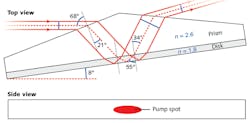A group at the US Army Research Laboratory (ARL; Adelphi, MD) has come up with a practical way of efficiently cooling both sides of an optically pumped thin disk-laser gain element, which may lead to better heat removal and beam quality for high-power disk lasers.1 The lasers are cooled by placing the disk in contact with a water-cooled heat sink; the heat is thus removed mostly from one side. Two-sided heat-sinking could more than double heat removal.
The problem is finding a heat-sink material for the emitting side of the laser disk that is transparent and highly conductive. Sapphire is highly conductive at the cryogenic temperature of 77 K and has been used to cool a laser disk, but at room temperature, the conductivity of sapphire is impractically low.
For cooling a ytterbium:YAG (Yb:YAG) disk laser, the researchers use silicon carbide (SiC), which has about the same conductivity at room temperature as copper. But SiC has its own problem: a high refractive index of 2.59 at a 1 μm wavelength. Because of this, a flat SiC window placed against a thin laser disk would cause a large single-pass loss of 3.3%. An antireflection coating would reduce this loss but would be thermally resistant and reduce the strength of the bond between the disk and the SiC heat sink.
Lossless reflections
So the researchers solved the light-loss problem by using a SiC prism instead of a flat plate, pumping the prism/disk assembly at an angle and designing the prism so that the laser beam strikes the surfaces in the assembly at the Brewster's angles for those surfaces (except for a single total internal reflection), which means that all losses are zero for p-polarized 800 nm pump light (see figure). The prism is 40 mm long from end to end and 8.3 mm thick at its apex; the gain layer is 0.4 mm thick. The disk layer was cooled only by the SiC prism, with the other surface kept open to the air so that the temperature distribution on the SiC could be measured with a thermal camera.
The assembly was placed in a stable-cavity arrangement with a slightly spherical dichroic pump mirror and a flat output mirror (for experimentation, various output mirrors with reflectances ranging from 70-98% were used). The laser was operated in a quasi-continuous-wave manner with a 10% duty cycle and 100 Hz repetition rate.
Because the fiber-guided pump source was unpolarized, 30% of the pump power was lost at the surfaces (this could be eliminated by a polarized pump source). The 85%-reflectance output mirror produced the best slope efficiency at ~38% with an output of 12 W. A high pump threshold density of 3 to 4 kW/cm2 led the researchers to model the laser and determine that the SiC itself had some absorption, causing a single-pass loss of ~3%.
A quality beam
The beam quality (M2) of the Yb:YAG laser output was good: about 1.5 in X and Y. The beam polarization contrast was at least 1000:1. Modeling showed that for 7.7 W of pump power, the temperature across the disk layer should vary by ~10°C; measurements with a thermal camera agreed.
The researchers note that the prism/disk laser design can be scaled up in power by elongating the pump spot along the prism base; an unstable-cavity configuration can boost power-extraction efficiency. Double-sided cooling can be accomplished by contacting the open side of the disk layer with a copper heat sink. A finite-element simulation shows that double-sided cooling will reduce temperature extremes by a factor of 2.5 or more.
REFERENCE
1. G.A. Newburgh et al., Opt. Exp., 18, 17066 (Aug. 2, 2010).

John Wallace | Senior Technical Editor (1998-2022)
John Wallace was with Laser Focus World for nearly 25 years, retiring in late June 2022. He obtained a bachelor's degree in mechanical engineering and physics at Rutgers University and a master's in optical engineering at the University of Rochester. Before becoming an editor, John worked as an engineer at RCA, Exxon, Eastman Kodak, and GCA Corporation.
